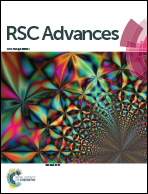Lineariifolianoids I–L, four rare sesquiterpene lactone dimers inhibiting NO production from Inula lineariifolia†
Abstract
A rare 4,5-seco-pseudoguaiane–guaiane type sesquiterpene lactone dimer lineariifolianoid I (1), together with three xanthane–guaiane type dimers lineariifolianoids J–L (2–4) were isolated from Inula lineariifolia. Their structures and absolute configurations were established on the basis of spectroscopic data and X-ray crystallography. Compounds 1 and 2 exhibited significant inhibitory activity against LPS-induced NO production in RAW 264.7 macrophages with IC50 values of 1.02, 1.79 μM.


 Please wait while we load your content...
Please wait while we load your content...